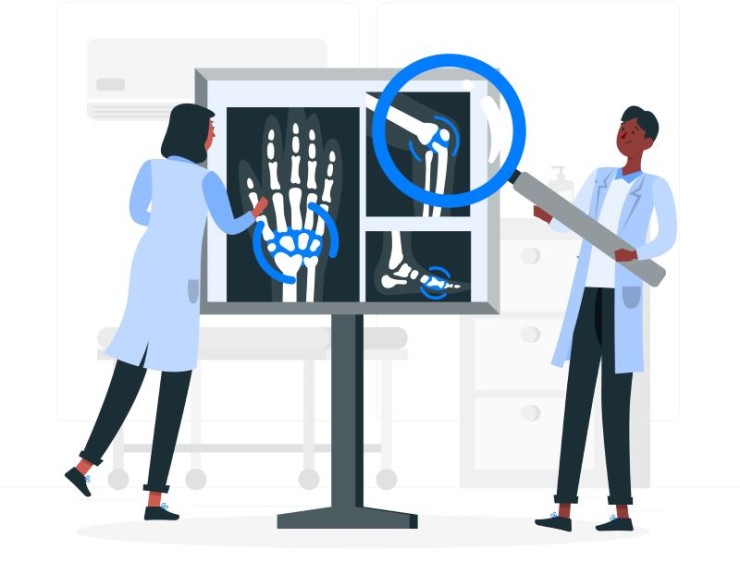
A Dual-Energy X-ray Absorptiometry (DEXA) Scan or Bone Mineral Density (BMD) Scan is a diagnostic test that measures bone density.
Bone Mineral Density or DEXA Scan with Cost
Unraveling Bone Health: A Comprehensive Guide to
DEXA Scan or BMD Scan
Introduction to DEXA Scan or BMD Scan
A Dual-Energy X-ray Absorptiometry (DEXA) Scan or Bone Mineral Density (BMD) Scan is a diagnostic test that measures bone density. This article aims to provide a detailed exploration of DEXA/BMD scans, their significance in bone health, and various aspects related to the procedure.
Importance of DEXA/BMD
Scan in Bone Health
DEXA/BMD scans play a crucial role in assessing bone health by quantifying bone density. These scans help identify conditions like osteoporosis and assess the risk of fractures, providing valuable insights into overall skeletal well-being.
Types of DEXA/BMD Scans
Different types of DEXA/BMD scans cater to specific diagnostic needs. Central DEXA measures bone density in the spine and hip, while Peripheral DEXA focuses on other skeletal sites. Each variant offers unique information about bone health.
Preparation for a DEXA/BMD Scan
Preparation for a DEXA/BMD scan is minimal. Patients are usually advised to wear comfortable clothing without metal accessories. It's essential to inform the healthcare provider about any recent contrast material or radiation exposure.
Procedure Overview
During a DEXA/BMD scan, the patient lies still on a scanning table while a low-dose X-ray beam passes through the bones. The amount of X-ray absorbed by the bones is measured, providing precise information about bone density.
Interpreting DEXA/BMD Results
Interpreting DEXA/BMD results involves comparing the patient's bone density with standard values for their age and gender. Results are typically presented as T-scores and Z-scores, indicating the deviation from the average bone density.
Indications for DEXA/BMD Testing
DEXA/BMD testing is recommended for individuals with risk factors for bone loss, including postmenopausal women, older adults, and those with a history of fractures. Detecting issues early enables timely intervention to halt any further deterioration of the bones.
Advantages of DEXA/BMD
in Disease Prevention
The primary advantage of DEXA/BMD lies in its ability to detect bone density changes early, enabling preventive measures against osteoporosis and fractures. Timely intervention, such as lifestyle modifications or medication, can mitigate the risk of bone-related issues.
Risks and Safety Measures
DEXA/BMD scans involve minimal radiation exposure, and the benefits of accurate bone density assessment outweigh the risks. Pregnant individuals are advised to inform healthcare providers, and alternative imaging methods may be considered in such cases.
Comparisons with Other Bone Density Tests
Comparing DEXA/BMD with other bone density tests, such as quantitative ultrasound or CT scans, highlights the unique strengths of exposure, and widespread availability.
Innovations and Advancements in DEXA/BMD Technology
Technological advancements continue to enhance DEXA/BMD capabilities. From improved imaging resolution to portable devices, innovations contribute to more accessible and efficient bone density assessments.
Patient Experience and Comfort
The DEXA/BMD procedure is quick and painless, with no need for anesthesia. Patients may be required to lie still for a short duration, and the open design of modern scanners contributes to a comfortable experience.
Follow-up Care and
Recommendations
After a DEXA/BMD scan, patients receive prompt results and recommendations for bone health maintenance. Lifestyle modifications, dietary adjustments, and, if necessary, medications may be suggested to preserve bone density.
Case Studies and Success Stories
Real-life case studies and success stories highlight the impact of DEXA/BMD testing in diagnosing and managing bone health issues. These narratives provide insights into the effectiveness of early intervention in preventing fractures and enhancing overall skeletal health.
Expert Insights and Recommendations
Leading experts in bone health share their insights and recommendations on the evolving landscape of DEXA/BMD technology. From interpreting results to preventive strategies, their perspectives contribute to optimal bone care.
Conclusion
In conclusion, DEXA/BMD scans stand as a cornerstone in bone health assessment, offering a non-invasive and precise means to evaluate bone density. Their role in early detection and prevention of bone-related conditions underscores their significance in maintaining skeletal well-being.
FAQs (Frequently Asked Questions) about BMD or DEXA Scan Test
Is a DEXA/BMD scan safe for pregnant individuals?
DEXA/BMD scans involve minimal radiation, but pregnant individuals should inform their healthcare providers. Alternative imaging methods may be considered during pregnancy.
How often should one undergo a DEXA/BMD scan?
The frequency of DEXA/BMD scans depends on individual risk factors and healthcare provider recommendations. Generally, postmenopausal women and older adults may undergo periodic scans to monitor bone health.
Can DEXA/BMD scans detect conditions other than osteoporosis?
While DEXA/BMD scans primarily assess bone density, they may also reveal other conditions affecting the skeletal system. Healthcare providers may use additional diagnostic methods for a comprehensive assessment.
Is there an age limit for undergoing a DEXA/BMD scan?
DEXA/BMD scans can be performed at any age, and there is no specific age limit. The decision to undergo a scan is based on individual health factors and risk assessments.
Can DEXA/BMD scans be done for non-skeletal purposes?
DEXA/BMD scans are primarily focused on assessing bone density. While they may indirectly provide insights into overall health, their primary application is in evaluating skeletal well-being.
Is a DEXA/BMD scan only for older adults?
While DEXA/BMD scans are commonly recommended for older adults, individuals of any age with risk factors for bone loss or specific medical conditions may benefit from bone density assessment.
Can medications interfere with DEXA/BMD results?
Certain medications, such as those for osteoporosis or corticosteroids, may affect bone density. It's crucial to inform the healthcare provider about all medications being taken to ensure accurate interpretation of DEXA/BMD results.
Is a DEXA/BMD scan uncomfortable?
No, a DEXA/BMD scan is a quick and painless procedure. Patients lie still on a scanning table for a short duration while the scan is performed. There is no discomfort associated with the scan itself.
Can DEXA/BMD scans detect fractures?
DEXA/BMD scans primarily assess bone density and are not designed to detect fractures directly. However, low bone density increases the risk of fractures, and identifying such risk through DEXA/BMD scans allows for preventive measures.
Are there dietary recommendations before a DEXA/BMD scan?
While there are no specific dietary restrictions, maintaining a balanced diet rich in calcium and vitamin D contributes to overall bone health. Healthcare providers may provide personalized recommendations based on individual nutritional needs.
(0)
Login to continue



